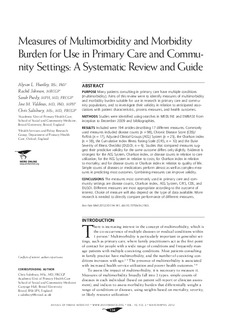Measures of Multimorbidity and Morbidity Burden for Use in Primary Care and Community Settings: A Systematic Review and Guide
Journal article

Åpne
Permanent lenke
http://hdl.handle.net/11250/2486833Utgivelsesdato
2012Metadata
Vis full innførselSamlinger
Originalversjon
Huntley, A. L., Johnson, R., Purdy, S., Valderas, J. M. & Salisbury, C. (2012). Measures of Multimorbidity and Morbidity Burden for Use in Primary Care and Community Settings: A Systematic Review and Guide. Annals Of Family Medicine, 10(2), 134-141. https://doi.org/10.1370/afm.1363Sammendrag
PURPOSE: Many patients consulting in primary care have multiple conditions (multimorbidity). Aims of this review were to identify measures of multimorbidity and morbidity burden suitable for use in research in primary care and community populations, and to investigate their validity in relation to anticipated associations with patient characteristics, process measures, and health outcomes.
METHODS: Studies were identified using searches in MEDLINE and EMBASE from inception to December 2009 and bibliographies.
RESULTS: Included were 194 articles describing 17 different measures. Commonly used measures included disease counts (n = 98), Chronic Disease Score (CDS)/RxRisk (n = 17), Adjusted Clinical Groups (ACG) System (n = 25), the Charlson index (n = 38), the Cumulative Index Illness Rating Scale (CIRS; n = 10) and the Duke Severity of Illness Checklist (DUSOI; n = 6). Studies that compared measures suggest their predictive validity for the same outcome differs only slightly. Evidence is strongest for the ACG System, Charlson index, or disease counts in relation to care utilization; for the ACG System in relation to costs; for Charlson index in relation to mortality; and for disease counts or Charlson index in relation to quality of life. Simple counts of diseases or medications perform almost as well as complex measures in predicting most outcomes. Combining measures can improve validity.
CONCLUSIONS: The measures most commonly used in primary care and community settings are disease counts, Charlson index, ACG System, CIRS, CDS, and DUSOI. Different measures are most appropriate according to the outcome of interest. Choice of measure will also depend on the type of data available. More research is needed to directly compare performance of different measures.